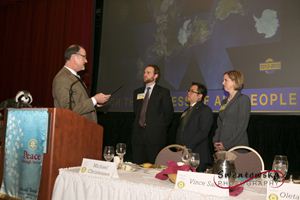Meeting Recap for January 14, 2013

(New Rotarians: Michael Christensen, Vince Sales, & Shirlee Tully with President Peter)
Who knew that the best way to protect against flooding is to punch holes in levees? Will S. Green knew… and thank goodness he did!
According to Rotary Club of Sacramento’s guest speaker Monday, former California Central Valley Flood Protection Board president, Ben Carter, Green is a big part of why we stay mostly dry.
Introduced by Past President George Basye, who was Chair of the Day, Carter detailed the 150-year history of the central valley’s flood control system. Green, a colorful character who came to California during the gold rush, became publisher of the Colusa Sun newspaper. He also was a steamboat captain, state treasurer and legislator. But most importantly (to our staying dry), he was U.S. Surveyor General for California and among the earliest and strongest advocates for creating a flood control system of weirs and bypasses.
Weirs are engineered breaks in levees through which high water from rivers can be directed into pre-planned flood basins (bypasses) when flows get too great and threaten to burst levees.
Back in the mid-late 1800s, some argued against bypasses and said that if levees were built strong, rivers would stay within their banks and scour out channels deep enough to handle flows. Green observed the natural process of rivers cutting channels and creating overflow basins and concluded it would be better to decide where to send water instead of chancing a natural break. That’s why today we have a system of weirs and bypasses—the most notable being Sutter Bypass and Yolo Bypass—that safely carry water away from populated areas.
How important is that system to keeping areas like the Natomas Basin dry? Carter provided some mind-boggling statistics. “In 1907,” he said, “flows in the Sacramento River reached 600,000 cubic feet per second; twice what anyone thought there would be. We had a true 100-year flood. “To put that into perspective, that’s enough water to completely fill Shasta, Whiskeytown, Oroville and Black Butte reservoirs in eight days; 10 Olympic swimming pools in just seconds. “The capacity of the Sacramento River below the Tower Bridge is only 100,000 cubic feet per second,” said Carter.
What keeps the overflow out of Natomas and downtown when flows exceed that? A weir just north of Sacramento is opened and the Yolo Bypass, capacity 500,000 cfs, floods instead of Natomas.
Of course, back in 1907, there were no major reservoirs upstream. Is that kind of flooding still a potential threat? “Last month, the weekend right before Christmas, the Sacramento River rose 21 feet at the Colusa Bridge in just one day,” said Carter, whose family farms in that area. “On a relative basis (based on the amount of land being drained), our river system carries 20 times the volume of the Mississippi.” “Recently we saw what happens when there are no bypasses. People were blowing up levees along the Missouri River to flood farm land and protect densely populated areas downstream.”
---
Mark Huffman gave a Centennial Moment presentation regarding the history of RCS and when the club first admitted non-whites. Using the club history written by the late F. Melvin Lawson, Huffman pointed out that grocer George Wong was the first non-white. He joined the club in June of 1966. The first African American, Dr. Ervin Jackson, Jr., joined about two years later.
---
Bill Stone announced that his challenge to Rotarians to match his gift to fund this year’s Rotaplast project had been met and that more than $7,500 had been pledged. On top of the $6,000 pledged by Bill and his wife, Millie, that closed the funding gap and will enable 100 children with cleft palates to receive the life-changing surgery.
---
John Phair and President Peter Dannenfelser II gave a brief slide presentation to update RCS on the clean water project it funded in Cambodia, when nine new wells were dug and 56 repaired three years ago.
---
President Peter inducted three new members into the club: Michael Christensen, sponsored by Jan Stohr and Hal Shipley; Shirlee Tully, sponsored by Ruth Blank and Oleta Lambert; and Vince Sales, sponsored by Oleta Lambert and Fred Teichert.
---
The Evergreen Company (Dan Cole) was the meeting sponsor, giving its time to President Peter to talk about the Relationship Skills Center (on whose board he serves) and the beneficiary of this year’s Bids for Kids. Past President Ken Noack, Jr., provided the thought for the day and Dick Osen led the club in singing “America the Beautiful.” Jeff Curcio and Steve Lamon sponsored the pre-meeting wine reception with Paul Stone supplying the great music.
---
President Peter also came up with a new revenue enhancement strategy. He asked all Rotarians wearing their Rotary pins to raise their hands. Then he asked those who were not to leave a $10 fine on their table. Rotarians are supposed to wear their pins with pride and daily.